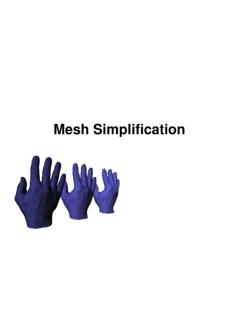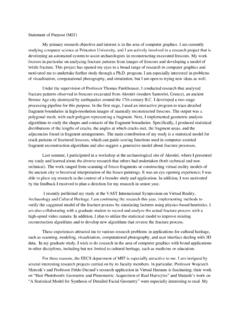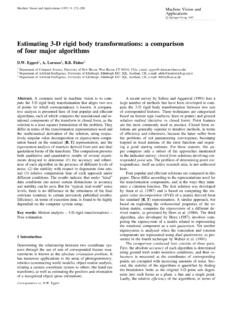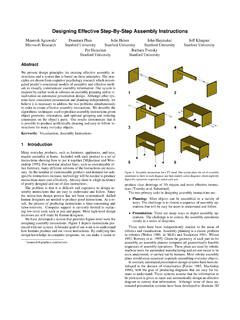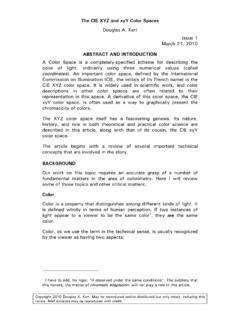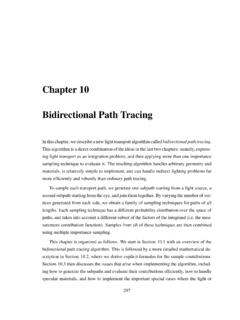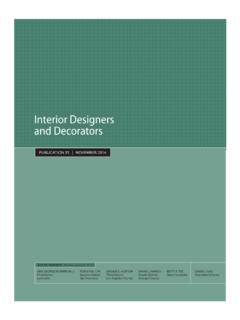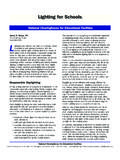Transcription of Interactive Furniture Layout Using Interior Design Guidelines
1 Interactive Furniture Layout Using Interior Design GuidelinesPaul Merrell1 Eric Schkufza1 Zeyang Li1 Maneesh Agrawala2 Vladlen Koltun11 Stanford University2 University of California, BerkeleyFigure 1: Interactive Furniture Layout . For a given Layout (left), our system suggests new layouts (middle) that respect the user s constraintsand follow Interior Design Guidelines . The red chair has been fixed in place by the user. One of the suggestions is shown on the present an Interactive Furniture Layout system that assists usersby suggesting Furniture arrangements that are based on Interior de-sign Guidelines . Our system incorporates the Layout Guidelines asterms in a density function and generates Layout suggestions byrapidly sampling the density function Using a hardware-acceleratedMonte Carlo sampler. Our results demonstrate that the suggestiongeneration functionality measurably increases the quality of furni-ture arrangements produced by participants with no prior trainingin Interior [Computer Graphics]: Methodology andTechniques Interaction techniques;Keywords: Furniture arrangement, Interior Design , Layout inter-faces, interactionLinks:DLPDFWEBVIDEO1 IntroductionYou are moving into a new home and need to arrange the livingroom Furniture .
2 You have a sofa, armchairs, coffee table, end tables,ottomans, and a media center. What arrangement will create themost comfortable and visually pleasing setting for your home? Furniture placement is challenging because it requires jointly opti-mizing a variety of functional and visual criteria. Skilled interiordesigners follow numerous high-level Guidelines in producing fur-niture layouts [Lyons 2008; Ward 1999]. In a living room for ex-ample, the Furniture should support comfortable conversation, alignwith prominent features of the space, and collectively form a vi-sually balanced composition. In practice these Guidelines are of-ten imprecise and sometimes contradictory. Experienced designerslearn to balance the tradeoffs between the Guidelines through aniterative trial-and-error most people responsible for furnishing a new home have notraining in Interior Design . They may not be aware of Interior de-sign Guidelines and they are unlikely to have the tacit knowledgeand experience required to optimally balance the tradeoffs.
3 In-stead such amateur designers rely on intuitive rules such as pushinglarge Furniture items against the walls. These intuitive rules oftenlead to functionally ineffective and visually imbalanced arrange-ments [Lyons 2008]. The resulting Furniture layouts simply don tlook or feel right, and even worse the amateur designer can t pin-point what the problems are [Ward 1999].In this paper, we identify a set of Interior Design Guidelines forfurniture Layout and develop an Interactive system based on theseguidelines. In our system, the user begins by specifying the shapeof a room and the set of Furniture that must be arranged within user then interactively moves Furniture pieces. In response,the system suggests a small set of Furniture layouts that follow theinterior Design Guidelines . The user can interactively select a sug-gestion and move any piece of Furniture to modify the Layout .
4 Thus,the user and computer work together to iteratively evolve the Design (Figure 1).Our approach represents the Furniture Layout Guidelines as termsin a density function and treats manual placement of pieces assubspace constraints. Since the resulting function is highly mul-timodal, we employ a Markov chain Monte Carlo sampler to sug-gest optimized layouts. To deal with the substantial computationalrequirements of stochastic sampling, we use graphics hardware toenable Interactive summary, our work makes two main contributions. First, weidentify and operationalize a set of Design Guidelines for furni-ture Layout . Second, we develop an Interactive system for creat-ing Furniture arrangements based on these Guidelines . Our resultsdemonstrate that the suggestion generation functionality of our sys-tem measurably increases the quality of Furniture arrangements pro-duced by users with no prior training in Interior BackgroundAssisted direct manipulation interfaces have been widely studiedin computer graphics, dating back to Ivan Sutherland s Sketch-Pad [Sutherland 1963].
5 In the context of architectural Design ,Harada et al. [1995] describe an interface for creating interface supports local constraints and invokes discrete lo-cal search whenever the user drives the Layout into a challeng-ing configuration. Likewise, Michalek and Papalambros [2002]use sequential quadratic programming to optimize an arrangementof rectangles in response to Interactive manipulation. These ap-proaches assist the Layout of general rectangular arrangements anddo not incorporate Furniture Layout on Furniture Layout , Bukowski and S equin [1995] intro-duce object association constraints that are designed to facili-tate direct manipulation of Furniture arrangements. For example,the user can constrain a bookshelf to slide along walls withoutpenetration or separation. Xu et al. [2002] present a constraint-based Furniture Layout system that incorporates pairwise relation-ships which enforce stability, non-penetration, and alignment.
6 Ger-mer and Schwarz [2009] describe an agent-based procedure for fur-niture Layout . In contrast to these techniques, our approach is basedon established Layout Guidelines employed by practicing interiordesigners. These Guidelines include global criteria such as visualbalance, which cannot be expressed as a collection of object asso-ciations or pairwise problems arise in a number of domains and one commonstrategy is to use optimization techniques to find a Layout that sat-isfies domain-specific criteria. Researchers have applied this op-timization approach to circuit board Layout [Sarrafzadeh and Lee1993], graph Layout [Tollis et al. 1998], component Layout in prod-uct Design [Cagan et al. 2002], document Layout [Jacobs et al. 2003;Hurst et al. 2009], UI Layout [Lok and Feiner 2001; Gajos et ], label Layout [Christensen et al. 1995; Vollick et al. 2007],and architectural floor plan Layout [Merrell et al.]
7 2010]. Most ofthese approaches were developed for off-line Layout and do not sup-port direct manipulation or generation of multiple high-quality many physical and software tools are available for visual-izing Furniture arrangements [Hendler 1981; Reif 1993; Autodesk2011], these tools simply alleviate the physical strain of movingfurniture pieces to prototype different layouts. The placement ofthe Furniture relies entirely on the user s expertise, which is ofteninsufficient to produce effective Furniture arrangements. Our sys-tem assists Furniture placement by providing optimized suggestionsbased on Interior Design OverviewFigure 2 gives an overview of interaction with our system. Ourinterface is inspired by Igarashi and Hughes [2001] work on sug-gestive interfaces. The user begins a Layout session by creating aroom and populating it with Furniture . The Furniture items are se-lected from a library that contains categorized 3D models in canon-ical orientation.
8 Throughout the session, the user can manipulatethe Furniture and request suggestions. This is further illustrated inthe supplementary suggestions are generated by sampling a density function, de-fined over the space of layouts of the current set of Furniture in thespecified room. The density function is defined Using idealized ana-lytical formulations of Interior Design Guidelines , described in Sec-tion 2. Sampling is performed with a Markov chain Monte Carlosampler, parallelized on graphics hardware. The sampler runs inFigure 2:System overview. In response to user manipulation, oursystem suggests new arrangements that respect user-specified con-straints and follow Interior Design separate process, so that the user can continue the session whilesuggestions are being suggestions allow the user to quickly experiment with manyarrangement options that are already optimized with respect to in-terior Design Guidelines .
9 The user can constrain the suggestions byfixing some of the items in place. The constraints simply reduce thedimensionality of the sampled space. This approach allows the userto progressively pin down the desired Furniture Layout GuidelinesFurniture Layout Design falls under the umbrella ofspace planning,a sub-field of Interior Design that deals with the allocation of spatialresources [Kilmer and Kilmer 1992; Kubba 2003; Pile 2007; Karlen2009]. To identify Guidelines for Furniture Layout we have consultedmanuals on Furniture Layout [Talbott 1999; Ward 1999; Sharp 2008]and have interviewed four professional designers who specialize inarranging effective Furniture Layout must address both functional and vi-sual criteria. Thefunctional criteriaevaluate how well the layoutsupports the human activities that take place in the space, such asconversation, rest, or movement. Thevisual criteriaconcern theperception of the Layout as a visual section describes some of these criteria and their idealized an-alytic formulations as terms in a density function.
10 Formally werepresent a Furniture Layout as a tupleI= (F,R,G), whereFisthe collection of Furniture items placed in the room,Ris a polygondelineating the boundaries of the room, andG 2 Fis a collectionof groups of Furniture pieces. Such groups can be formed by theuser during an Interactive Layout session with our Functional CriteriaFunctional criteria for Furniture Layout are based on the constraintsimposed by human physiology and the effects of spatial Layout onhuman study of statistical distributions of human physical character-istics, such as body sizes and shapes, is known as anthropomet-rics. This study establishes Guidelines for the necessary clearancearound objects and for the proper distances and angles between ob-jects [Panero and Repetto 1975; DeChiara et al. 2001; McGowanand Kruse 2004]. Table 1 lists the anthropometric constraints usedin our implementation and Section describes our constraint au-thoring 3:A real-world Furniture Layout before (left) and after(right) professional rearrangement (reproduced from [Ward 1999]).

